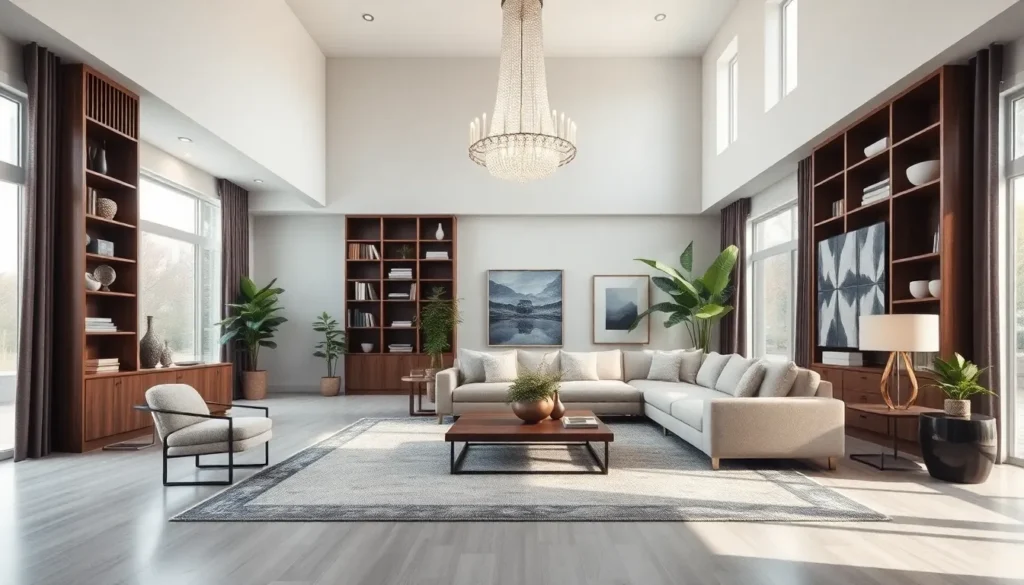High ceilings can transform any living room from ordinary to extraordinary but they also present unique design challenges. We’ve all walked into a space with soaring ceilings and felt either amazed by the grandeur or overwhelmed by the emptiness. The key lies in knowing how to work with that vertical space effectively.
When we’re dealing with high ceiling living rooms we need to think beyond traditional decorating rules. These dramatic spaces offer incredible opportunities to create visual impact through scale lighting and architectural details. But without the right approach they can feel cold and disconnected.
We’ll explore proven strategies that help you embrace your room’s vertical potential while maintaining warmth and functionality. From statement lighting fixtures to strategic furniture placement these high ceiling living room ideas will help you create a space that’s both impressive and inviting.
Embrace Dramatic Lighting Solutions for High Ceiling Living Rooms
Strategic lighting transforms towering spaces into warm, inviting environments that showcase your room’s architectural drama. We’ll explore three essential lighting approaches that maximize the impact of your vertical space.
Install Statement Chandeliers as Focal Points
Statement chandeliers command attention in high ceiling living rooms by drawing the eye upward and creating visual anchors. We recommend selecting fixtures that measure at least 30 inches in diameter for rooms with 12 foot ceilings, scaling up proportionally for taller spaces. Crystal chandeliers add elegance and sparkle, while modern geometric designs bring contemporary flair to your vertical canvas.
Position your chandelier 7 to 8 feet above the floor to ensure proper clearance while maintaining dramatic impact. Multi tier designs work exceptionally well in spaces exceeding 15 feet, as they fill the vertical void without overwhelming the room’s proportions. Brass and bronze finishes complement traditional decor styles, whereas black iron and brushed steel enhance modern high ceiling aesthetics.
Consider installing dimmer switches to control the intensity and mood throughout different times of day. Oversized drum chandeliers provide softer illumination for casual gatherings, while crystal cascade styles create formal dining atmospheres. We’ve found that pairing statement chandeliers with complementary wall sconces enhances the overall lighting scheme.
Layer Multiple Light Sources at Different Heights
Layered lighting creates depth and dimension in high ceiling living rooms by establishing multiple focal points throughout the vertical space. We suggest combining ambient, task, and accent lighting at three distinct levels: ceiling mounted fixtures, mid level installations, and floor based options.
Recessed lighting serves as your ambient foundation, spacing fixtures 6 to 8 feet apart across the ceiling plane. Track lighting systems offer flexibility for highlighting artwork or architectural features on tall walls. Pendant lights suspended at varying heights add visual interest and break up expansive ceiling areas.
Wall mounted sconces installed at 60 to 66 inches from the floor provide intermediate lighting layers that bridge the gap between ceiling and furniture levels. Picture lights illuminate artwork while creating warm pools of light on vertical surfaces. String lights or LED strips hidden behind crown molding add subtle uplighting that enhances the room’s grandeur.
Table lamps on console tables and side tables contribute to the lower lighting tier while adding decorative elements. We recommend using bulbs with different color temperatures to create visual variety: warm white (2700K) for cozy areas and cool white (3000K) for task oriented spaces.
Use Floor-to-Ceiling Lamps to Fill Vertical Space
Floor to ceiling lamps maximize your high ceiling living room’s vertical potential by creating striking columns of light that emphasize height. We favor torchiere style lamps that direct light upward, bouncing illumination off the ceiling to create ambient glow throughout the space. These fixtures typically stand 70 to 84 inches tall, making them perfect for rooms with 10 to 12 foot ceilings.
Arc floor lamps with extended reaches can illuminate seating areas while their curved silhouettes add sculptural interest to empty corners. Tree lamps featuring multiple adjustable arms provide targeted task lighting at various heights, functioning like vertical track systems. Contemporary tower lamps with slim profiles fit seamlessly into modern high ceiling designs without cluttering floor space.
Position tall lamps behind furniture groupings to create layered lighting effects that don’t interfere with conversation areas. Adjustable floor lamps offer versatility for reading nooks and workspaces, while their towering presence helps balance the scale of oversized furniture. We recommend choosing lamps with weighted bases to ensure stability in high traffic areas.
Ribbed glass and fabric drum shades diffuse light evenly throughout tall rooms, while metal mesh designs create interesting shadow patterns on walls and ceilings. Smart bulbs in floor to ceiling lamps allow for color temperature adjustments that complement your room’s changing needs throughout the day.
Create Visual Interest with Tall Wall Treatments

Tall wall treatments can transform your high ceiling living room from overwhelming to inviting. We’ll explore three strategic approaches that use your vertical space while adding warmth and visual depth.
Install Floor-to-Ceiling Built-in Shelving
Floor-to-ceiling built-in shelving serves as the perfect anchor for rooms with soaring heights. These vertical storage answers create structure while maximizing your room’s functionality.
We recommend designing shelving units that reach all the way to your ceiling to establish visual continuity. Built-in shelves provide endless opportunities for displaying decorative items, books, and personal collections that reflect your style.
Custom shelving allows you to create proportional balance in your space. The vertical lines draw the eye upward while preventing your room from feeling cavernous or empty.
Storage becomes both practical and beautiful when you incorporate adjustable shelves. This flexibility lets you accommodate items of varying heights while maintaining clean, organized displays.
Add Vertical Wood Paneling or Wainscoting
Vertical wood paneling brings instant warmth to high ceiling spaces while creating sophisticated texture. This treatment helps break up expansive wall surfaces and adds architectural interest.
We suggest installing wood panels that extend from floor to ceiling for maximum impact. The vertical lines naturally guide the eye upward while creating a sense of intimacy in larger spaces.
Wainscoting offers another elegant option that combines traditional charm with modern functionality. This treatment typically covers the lower portion of walls but can be extended higher in rooms with dramatic ceiling heights.
Different wood finishes and stain colors allow you to customize the look to match your existing decor. Lighter woods brighten the space while darker tones create dramatic contrast.
Design Gallery Walls That Reach Up High
Gallery walls that extend toward your ceiling create stunning focal points while utilizing your vertical real estate. These curated displays add personality and visual weight to otherwise empty wall space.
We recommend starting your gallery wall at standard eye level and extending it upward to take advantage of your room’s height. This approach creates continuity between your living area and the soaring space above.
Framed pieces of varying sizes work best when arranged in a cohesive layout that draws the eye naturally upward. Mix artwork, photographs, and decorative objects to create visual interest and depth.
Strategic spacing between pieces ensures your gallery wall doesn’t feel cluttered while maintaining visual flow. Consider using a consistent frame style or color palette to unify the entire display.
Incorporate Oversized Furniture to Balance Scale
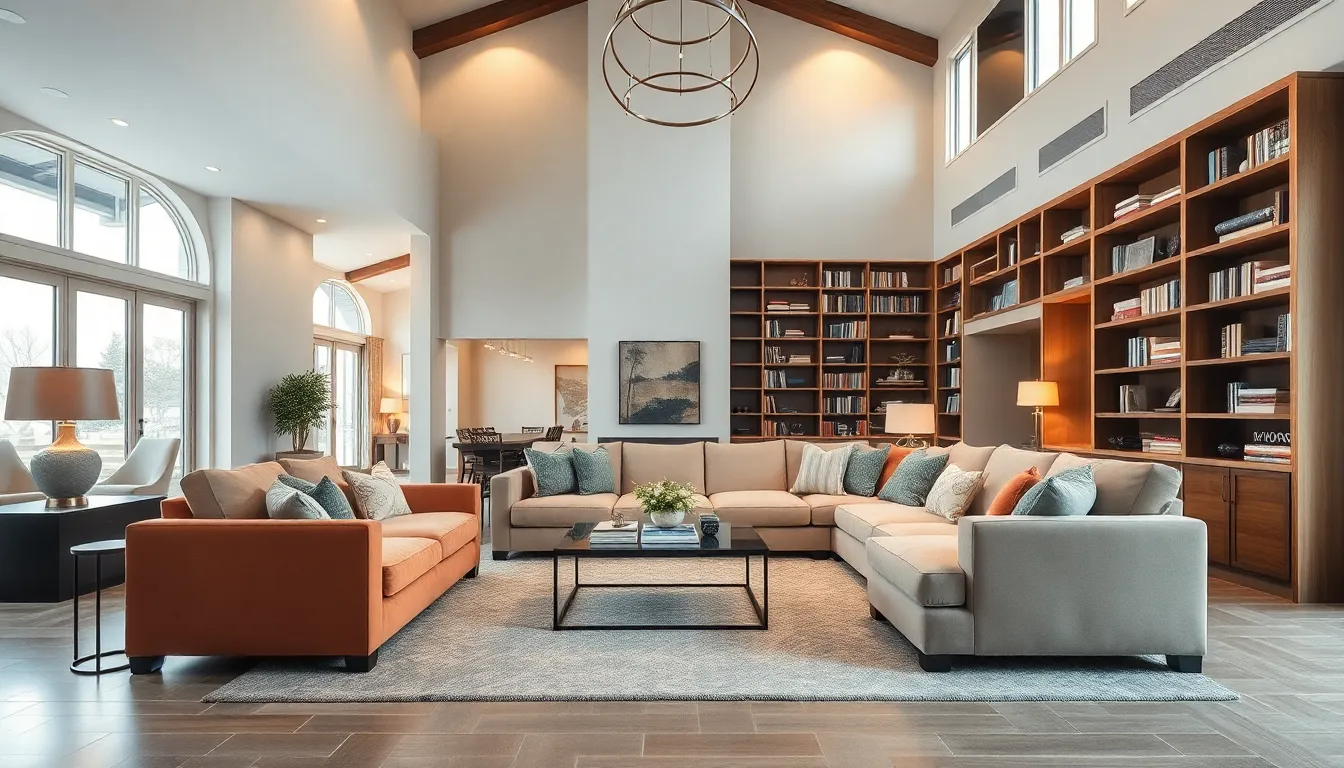
High ceiling rooms need furniture that matches their grand proportions to prevent spaces from feeling dwarfed or disconnected. We’ll explore strategic furniture choices that create visual harmony while maintaining comfort and functionality.
Choose Large Sectional Sofas and Oversized Chairs
Large sectional sofas serve as commanding focal points that ground high ceiling living rooms effectively. We recommend selecting pieces with substantial height and width to create proper scale against towering walls. Oversized chairs placed strategically throughout the space enhance both comfort and visual appeal while filling vertical gaps that standard furniture can’t address.
Sectional configurations work best when positioned to define conversation areas within expansive rooms. We suggest L-shaped or U-shaped arrangements that create intimate seating zones while utilizing the room’s generous square footage. Oversized armchairs positioned near windows or in reading nooks add functionality while maintaining the room’s balanced proportions.
High back furniture pieces naturally draw the eye upward, creating visual connections between floor and ceiling levels. We find that chairs with tall headrests or wingback designs particularly effective for bridging vertical space gaps.
Select Tall Bookcases and Entertainment Centers
Tall bookcases effectively use vertical space while adding practical storage and visual depth to high ceiling rooms. We recommend floor-to-ceiling bookcases that create dramatic focal points while maximizing functional storage capacity. These pieces help break up expansive wall surfaces and add warmth through their rich textures and organized displays.
Entertainment centers designed for high ceiling spaces should extend upward to create proper proportional balance. We suggest units that incorporate multiple levels of storage and display areas, allowing for both media equipment and decorative elements. Built-in entertainment centers work particularly well as they can be customized to fit exact ceiling heights and room dimensions.
Vertical storage answers serve dual purposes in these dramatic spaces. We find that combining open shelving with closed storage creates visual interest while maintaining clean lines that complement the room’s architectural features.
Add Grand Dining Tables for Open Concept Spaces
Grand dining tables create seamless flow between living and dining areas in open concept high ceiling spaces. We recommend selecting tables with substantial presence that can hold their own against the room’s dramatic proportions. These pieces serve as natural bridges between different functional zones while maintaining visual continuity throughout the space.
Open concept layouts benefit from dining tables that complement rather than compete with living room furniture. We suggest coordinating materials and finishes between dining and seating areas to create cohesive design flow. Large dining tables with interesting bases or unique materials add sculptural elements that enhance the room’s overall aesthetic.
Strategic placement of grand dining tables helps define separate areas within open floor plans while maintaining sight lines and conversation flow. We find that positioning these pieces where they’re visible from multiple angles creates natural gathering points that bring people together across the expansive space.
Utilize Vertical Space with Strategic Decor Placement
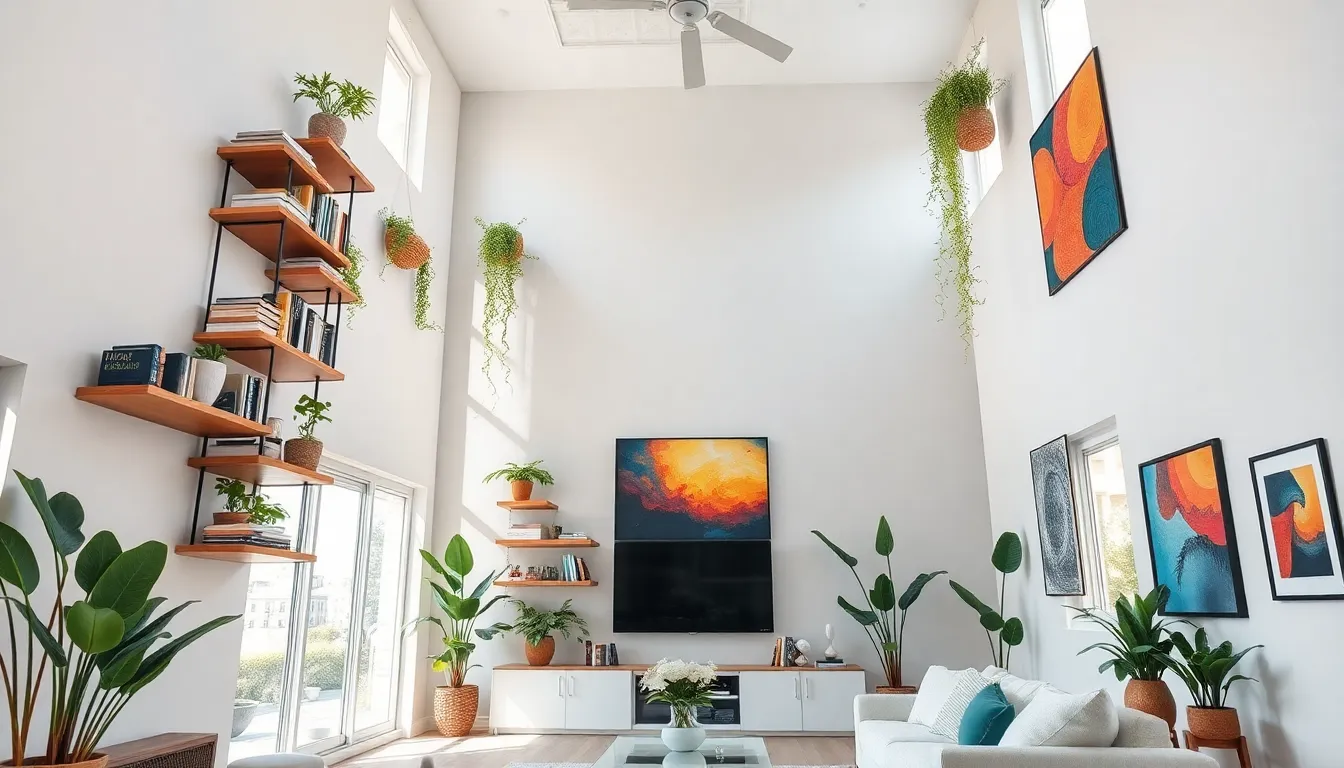
Strategic decor placement transforms high ceiling living rooms from overwhelming spaces into visually balanced environments. We’ll explore three powerful techniques that draw the eye upward while creating depth and interest throughout your vertical space.
Hang Artwork at Multiple Levels
Varying artwork heights creates ever-changing visual flow that emphasizes your ceiling’s impressive dimensions. We recommend hanging pieces at different elevations to establish a natural progression that guides the eye from floor to ceiling. Position larger statement pieces at traditional eye level (57-60 inches from the floor) while placing smaller complementary works higher up the wall.
Create visual clusters by grouping artwork at three distinct height zones: lower third, middle section, and upper areas. This layered approach prevents your walls from appearing bare while showcasing your collection’s full potential. Consider installing picture ledges at varying heights to display rotating artwork collections that can be easily updated seasonally.
Gallery lighting enhances this multi level approach by illuminating each piece individually. We suggest using adjustable track lighting or picture lights to highlight artwork at different heights, creating dramatic shadows that add depth to your high ceiling space.
Install Floating Shelves at Varying Heights
Floating shelves at staggered heights provide both functional storage and compelling visual interest across your tall walls. We position shelves at irregular intervals to create an organic, asymmetrical arrangement that feels intentional rather than rigid. Start with a shelf at 8 feet, add another at 6 feet, then place a third at 10 feet to establish ever-changing rhythm.
Display collections of books, decorative objects, and plants on these shelves to fill vertical space meaningfully. Varying shelf lengths adds another layer of visual complexity while accommodating different sized objects. We recommend using shelves ranging from 24 to 48 inches long to create balanced compositions.
Weight distribution becomes crucial when installing shelves at greater heights. Ensure proper wall anchoring using heavy duty brackets rated for your intended load, especially when displaying books or substantial decorative pieces on upper level shelves.
Display Tall Plants and Decorative Objects
Tall plants bridge the gap between floor and ceiling while introducing natural warmth to high ceiling spaces. We select floor plants reaching 6 to 8 feet in height, such as fiddle leaf figs, rubber trees, or bird of paradise plants, to create vertical anchors throughout the room. Position these statement plants in corners or beside large furniture pieces to establish visual continuity.
Decorative objects like oversized vases, sculptural pieces, and tall candle holders add sophisticated height variation across different surfaces. We place 3 to 4 foot tall vases on console tables, mantels, and built in shelving to create vertical interest at multiple levels. Sculptural elements ranging from 2 to 5 feet tall serve as artistic focal points that complement your room’s overall design scheme.
Layering different heights creates depth perception that makes high ceiling rooms feel more intimate. Combine floor standing pieces with elevated decorative objects on tables and shelves to establish a cohesive vertical industry that feels both grand and welcoming.
Define Zones in Large High Ceiling Living Rooms
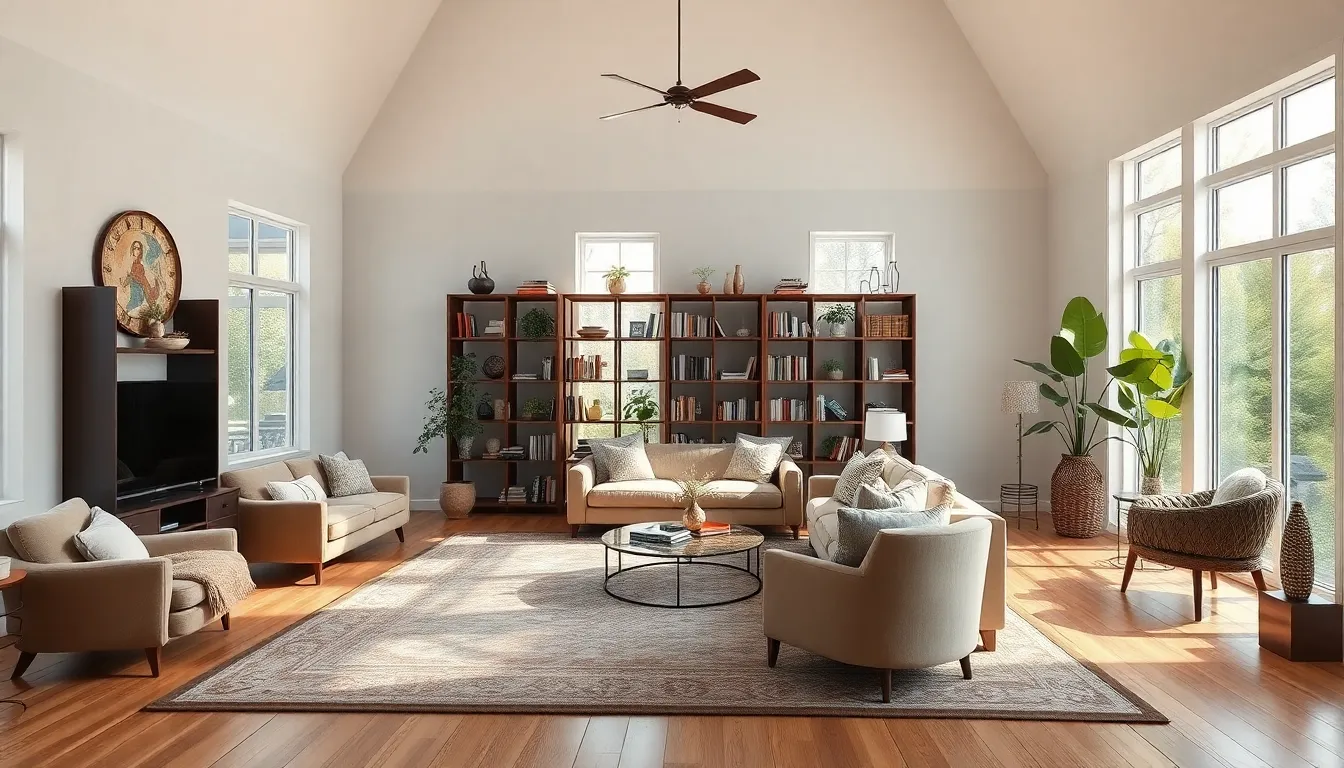
Dividing expansive high ceiling spaces into functional zones transforms overwhelming rooms into organized, purposeful areas. Strategic zoning helps manage vast vertical and horizontal space while creating intimate gathering spots within the larger room.
Create Conversation Areas with Area Rugs
Anchor conversation areas with substantial rugs that ground seating arrangements and define social spaces. We recommend selecting rugs large enough to accommodate all key furniture pieces, including sofas, coffee tables, and accent chairs. Large area rugs create visual boundaries that make high ceiling rooms feel more intimate and connected.
Position plush seating around these anchored zones to encourage natural interaction and conversation flow. Coffee tables, decorative pillows, and throws enhance the comfort factor while reinforcing each zone’s distinct purpose. Strategic rug placement helps organize multiple seating groups throughout expansive living rooms without creating visual chaos.
Different rug textures and patterns can distinguish various zones while maintaining overall design cohesion. Persian rugs work beautifully for formal conversation areas, while contemporary geometric patterns suit modern entertainment zones. Layering smaller accent rugs over larger base rugs adds depth and visual interest to each defined space.
Use Room Dividers and Screens Effectively
Room dividers offer flexible spatial separation without sacrificing natural light or creating permanent barriers. Decorative screens can delineate living areas from dining spaces or work zones while maintaining the open feel that high ceilings provide. We suggest choosing dividers that complement your existing decor while serving dual purposes as functional and aesthetic elements.
Tall bookcases function excellently as room dividers, providing storage and display opportunities while creating distinct zones. These vertical elements help reduce the cavernous feel of high ceilings by breaking up expansive floor space into manageable sections. Strategic bookcase placement allows for easy rearrangement as your space needs evolve.
Shelving units with open designs maintain visual flow between zones while offering practical storage answers. Plants, books, and decorative objects displayed on these dividers add personality and warmth to each separated area. Sliding panels or folding screens provide temporary division options for spaces that require occasional privacy or different configurations.
Establish Reading Nooks and Workspaces
Create dedicated reading corners using comfortable armchairs paired with side tables and adjustable floor lamps. Position these intimate zones near windows to maximize natural light while ensuring they feel integrated within the larger room layout. We recommend adding small bookshelves or floating shelves nearby to complete the cozy reading atmosphere.
Workspaces require strategic placement to balance productivity with the room’s overall flow and function. Small desks or writing tables positioned against walls or near built-in storage create defined work areas without overwhelming the living space. Proper task lighting ensures these zones remain functional throughout different times of day.
Strategic furniture arrangement ensures these specialized areas feel purposeful yet connected to the main living space. Area rugs help define each nook’s boundaries while comfortable seating options encourage regular use. Adding personal touches like favorite books, artwork, or plants makes these zones feel truly integrated into your high ceiling living room’s overall design scheme.
Add Warmth with Textiles and Soft Furnishings
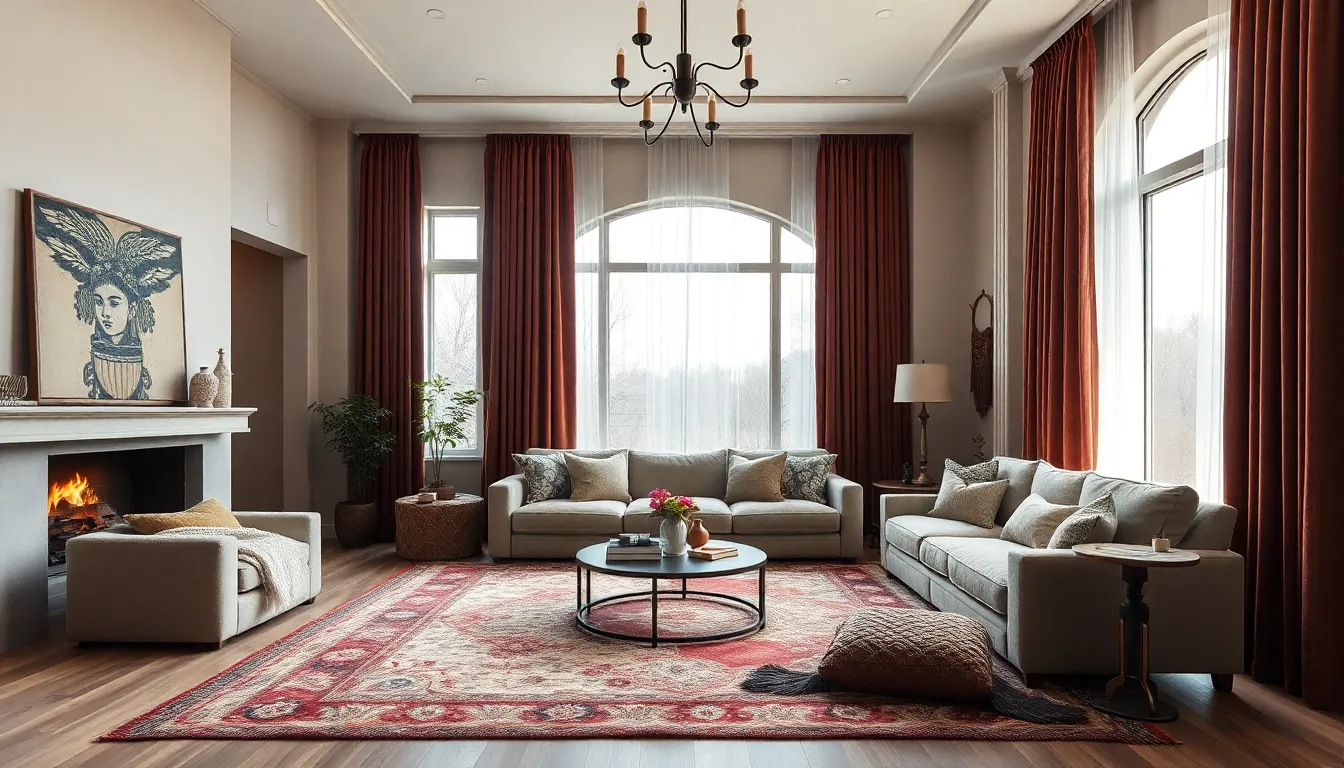
Textiles and soft furnishings serve as our most effective tools for counteracting the potential coldness of high ceiling spaces. Rich fabrics and warm colors transform these dramatic rooms into inviting retreats where families naturally gather.
Layer Rugs to Ground the Space
Large rugs anchor seating areas and create visual weight that grounds high ceiling living rooms effectively. Positioning substantial rugs underneath conversation areas helps define intimate spaces within the larger room while adding essential warmth underfoot. Layering multiple rugs adds depth and texture, creating visual interest that draws the eye downward to balance the room’s vertical emphasis.
We recommend selecting rugs that extend beyond the front legs of sofas and chairs to properly anchor furniture groupings. Persian rugs, natural fiber options like jute or sisal, and plush wool designs work particularly well in high ceiling spaces. The layering technique involves placing a larger neutral rug as the foundation, then adding a smaller patterned or textured rug on top for visual complexity.
Include Tall Curtains and Drapes
Floor to ceiling curtains create visual continuity that helps bridge the gap between furniture and soaring ceilings. Installing curtain rods close to the ceiling line rather than just above window frames maximizes the vertical impact while making windows appear larger and more proportionate to the room. Heavy fabrics like velvet, linen, or wool blends add substantial visual weight that balances the room’s scale.
We suggest choosing curtains that pool slightly on the floor for an elegant, luxurious appearance that adds visual anchoring. Rich jewel tones, warm neutrals, or textured fabrics work exceptionally well in high ceiling spaces. Layering sheer panels behind heavier drapes provides flexibility for light control while maintaining the room’s cozy atmosphere throughout different times of day.
Incorporate Cozy Throws and Oversized Pillows
Oversized pillows and plush throws create inviting focal points that encourage relaxation in high ceiling living rooms. These soft accessories add immediate warmth to seating areas while introducing color, pattern, and texture that personalizes the expansive space. Mixing different textures like chunky knit throws, velvet pillows, and faux fur accents creates visual richness that makes the room feel more intimate.
We recommend grouping pillows in odd numbers and varying their sizes from standard to oversized for visual appeal. Throws draped casually over chair arms or folded at sofa ends create an effortless, lived in feeling that counters any potential formality of high ceiling spaces. Warm colors like deep burgundy, rich navy, or earthy terracotta help create the cozy atmosphere that makes these dramatic rooms feel like home.
Install Architectural Elements for Added Character

Architectural elements transform high ceiling living rooms by adding visual interest and breaking up expansive vertical spaces. These structural features create depth and character while maintaining the room’s grand proportions.
Add Exposed Beams for Rustic Appeal
Exposed beams bring rustic charm and natural warmth to high ceiling living rooms. We recommend installing wooden beams that span the ceiling width to create visual boundaries in large spaces. Natural wood beams add earthiness and texture, while painted versions can complement your existing color palette. These structural elements draw the eye upward and create a cozy, intimate atmosphere even though the room’s impressive height.
Reclaimed wood beams offer authentic character with their weathered patinas and unique grain patterns. Cedar, oak, and pine beams provide different aesthetic qualities – cedar brings aromatic warmth, oak offers rich grain detail, and pine delivers affordable rustic appeal. Installing beams at regular intervals creates rhythm and visual flow across the ceiling plane.
Install Crown Molding and Decorative Trim
Crown molding elevates high ceiling rooms by adding sophisticated architectural detail and visual sophistication. We suggest selecting molding profiles that match your home’s architectural style – ornate designs for traditional spaces and clean lines for modern interiors. Installing crown molding creates a finished appearance that frames the ceiling and adds elegance to the room’s proportions.
Decorative trim work enhances the grandeur of high ceiling spaces through detailed craftsmanship and visual complexity. Chair rails, baseboards, and window casings work together to create cohesive architectural detail throughout the room. These elements add layers of visual interest while maintaining the room’s open, airy feeling.
Create Coffered Ceilings for Classic Elegance
Coffered ceilings provide classic luxury through their grid pattern of recessed panels and dimensional depth. We recommend designing coffered systems that complement your room’s proportions – larger panels for expansive spaces and smaller grids for more intimate areas. These architectural features break up vast ceiling surfaces while adding sophisticated visual weight to the room.
Installing coffered ceilings involves creating a framework of beams that form geometric patterns across the ceiling surface. The recessed panels can be painted in contrasting colors to emphasize the architectural detail or kept monochromatic for subtle sophistication. This design approach provides a timeless, luxurious look that transforms high ceiling spaces into refined living environments.
Maximize Natural Light in High Ceiling Spaces
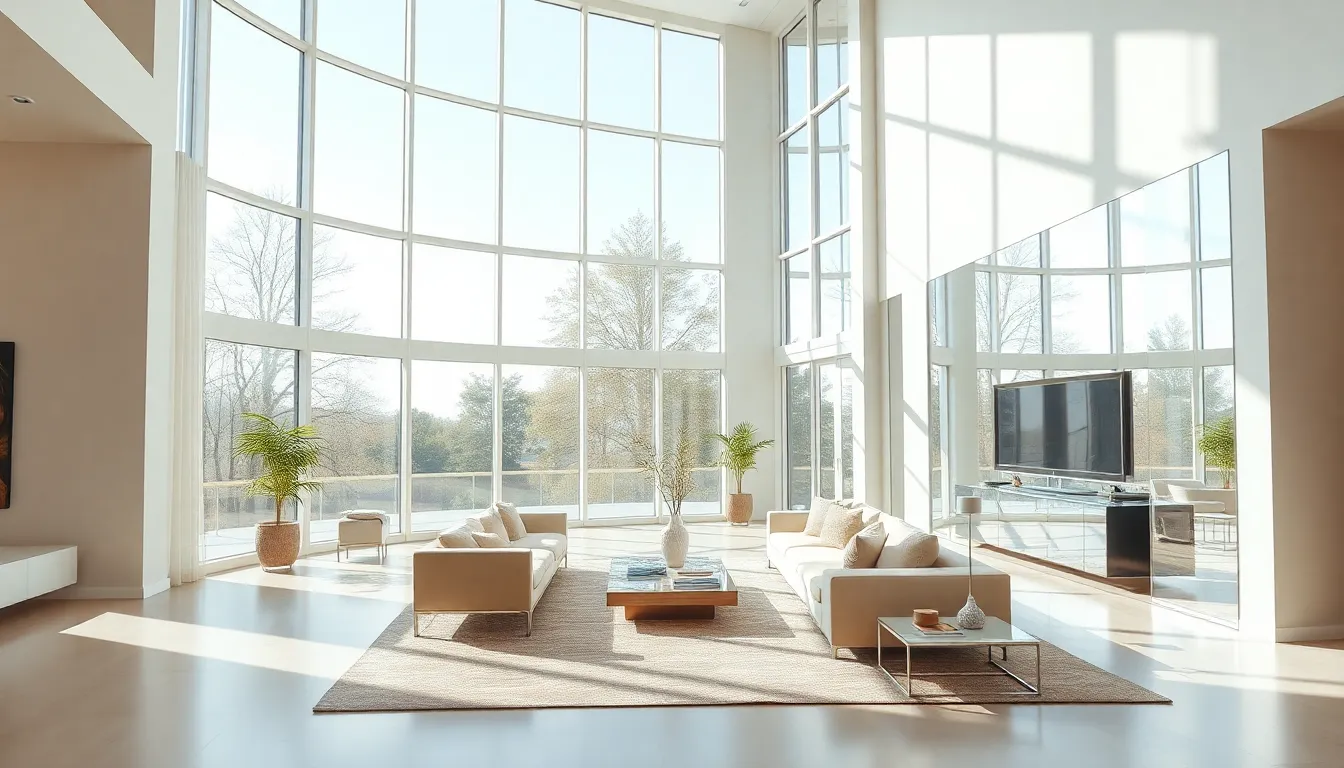
Natural light transforms high ceiling living rooms into bright, airy sanctuaries that feel both spacious and welcoming. We’ll explore three essential strategies to flood your vertical space with beautiful daylight.
Install Floor-to-Ceiling Windows
Floor-to-ceiling windows create the most dramatic impact in high ceiling spaces by allowing abundant natural light to enter the room. These expansive glass panels make rooms feel significantly larger and more spacious while establishing a seamless connection between indoor and outdoor environments.
Consider installing custom window treatments that complement your windows’ impressive height. We recommend mounting curtain rods just below the ceiling line to emphasize the vertical expanse. Large window panels also serve as architectural features themselves, creating clean lines that enhance modern design aesthetics.
Professional installation ensures proper insulation and energy efficiency for these substantial windows. Double or triple-pane glass options provide excellent thermal performance while maintaining crystal-clear views. Strategic placement of these windows can frame outdoor landscapes like living artwork within your high ceiling space.
Add Skylights for Overhead Illumination
Skylights bring natural light from above while improving the sense of openness and grandeur in high ceiling spaces. These overhead windows flood rooms with even, diffused light throughout the day, reducing dependence on artificial lighting sources.
Various skylight styles complement different architectural designs and ceiling configurations. Fixed skylights offer consistent illumination, while operable versions provide ventilation benefits during pleasant weather. Tubular skylights work well in spaces where traditional skylights aren’t feasible, channeling light through reflective tubes.
Modern skylight technology includes automated rain sensors and remote-controlled operation for ultimate convenience. Energy-efficient glazing options reduce heat gain during summer months while maximizing light transmission. Strategic skylight placement creates stunning light patterns that change throughout the day, adding ever-changing visual interest to your high ceiling room.
Use Mirrors to Reflect and Amplify Light
Mirrors positioned opposite windows or skylights reflect natural light and create a brighter, more airy atmosphere throughout high ceiling spaces. Large mirrors amplify existing light sources while creating the illusion of additional windows and expanded space.
Strategic mirror placement doubles the impact of your natural light sources. We suggest installing oversized mirrors on walls perpendicular to windows to maximize light reflection without creating glare. Grouping multiple mirrors at different heights creates layered light reflection that fills vertical space effectively.
Decorative mirror frames add style while serving this functional purpose. Antique mirrors with aged glass create soft, romantic light reflection, while modern frameless options maintain clean, contemporary aesthetics. Mirrored furniture pieces like coffee tables and side tables provide additional light reflection at floor level, creating comprehensive illumination throughout your high ceiling living room.
Conclusion
High ceiling living rooms offer incredible potential for creating stunning spaces that make a lasting impression. By implementing these design strategies we’ve covered you’ll transform your soaring space into a warm and inviting environment that feels both grand and comfortable.
Remember that success lies in balancing scale proportion and functionality. Whether you’re adding statement lighting incorporating oversized furniture or creating cozy zones each element should work together to enhance your room’s natural drama while maintaining intimacy.
With thoughtful planning and the right design choices your high ceiling living room will become the showstopping centerpiece of your home – a space that’s both visually impressive and perfectly livable for everyday enjoyment.
Frequently Asked Questions
How do you make a high ceiling living room feel less empty?
Use oversized furniture like large sectional sofas and tall bookcases to fill vertical space. Layer lighting at different heights with statement chandeliers and floor-to-ceiling lamps. Add tall wall treatments such as built-in shelving or wood paneling. Create gallery walls that extend upward and incorporate tall plants to bridge the gap between floor and ceiling.
What type of lighting works best for high ceiling rooms?
Install statement chandeliers proportionate to the room’s height as focal points. Layer multiple light sources at different levels, combining ambient, task, and accent lighting. Use floor-to-ceiling lamps to fill vertical space and add gallery lighting for artwork. This creates depth and prevents the space from feeling cavernous.
How can I define zones in a large high ceiling living room?
Use substantial area rugs to anchor conversation areas and create intimate gathering spots. Install tall bookcases as room dividers that provide storage while maintaining visual flow. Create dedicated reading nooks and workspaces with strategic furniture placement. Room dividers and screens can separate spaces without blocking natural light.
What furniture scale works best for high ceiling spaces?
Choose oversized furniture that matches the room’s proportions, including large sectional sofas and high-back chairs. Select tall entertainment centers and bookcases that utilize vertical space effectively. Use grand dining tables in open concept areas to create visual continuity. The furniture should create visual harmony without being dwarfed by the ceiling height.
How do textiles help warm up high ceiling rooms?
Layer large area rugs to ground seating areas and add visual weight to the space. Hang tall curtains from ceiling to floor to create vertical continuity. Incorporate cozy throws and oversized pillows in rich fabrics and warm colors. Mix textures through layered rugs and soft furnishings to create intimacy and warmth.
What are the best ways to maximize natural light in high ceiling spaces?
Install floor-to-ceiling windows to create dramatic impact and connect indoor-outdoor spaces. Add skylights for overhead illumination that enhances the sense of openness. Use strategically placed mirrors to reflect and amplify existing natural light throughout the room. These elements create a brighter, more airy atmosphere while showcasing the impressive ceiling height.
